#Conan Doyle: A Biographical Solution
Explore tagged Tumblr posts
Text

シャーロック・ホームズの生れた家 ロナルド・ピアソール、小林司・島弘之=訳 河出文庫 カバー=画・山本里美、デザイン・BISE、フォーマット=粟津潔
#Conan Doyle: A Biographical Solution#シャーロック・ホームズの生れた家#Ronald Pearsall#ロナルド・ピアソール#tsukasa kobayashi#小林司#hiroyuki shima#島弘之#河出文庫#山本里美#kiyoshi awazu#粟津潔#anamon#古本屋あなもん#あなもん#book cover
5 notes
·
View notes
Text
Arthur Conan Doyle: Memoirs and Letters, pt.1
Crossposted from the Victorian Holmes community on DW.
On May 22 was the 160th anniversary of ACD’s birthday, and I made reviews of two books about him to commemorate the date.
The first one was Memories and Adventures, penned by ACD himself in 1924. When I started to write Holmes fic, I wanted to get some insight into ACD’s creative process and learn more about him to build headcanons about Watson (and Holmes too). Having come across ACD’s memoirs, I read them avidly. They are written in ACD’s signature style: clear, fun, and easy to read. His life was as adventurous as his short stories and novels, and his way of storytelling defined my view of Watson’s narrative. Something was embellished, something glossed over, and something omitted, but on the whole it was a candid account.
- For example, he is graphic and shockingly straightforward, writing about the severe corporal punishment he suffered as a boy at Stonyhurst, a Jesuit school he attended, and which made him cast off his Roman-Catholic faith.
- However, he glosses over the fact of his father’s alcoholism and how terribly it affected the Doyle family. Mary Doyle had to raise seven children single-handedly in poverty while caring after her incapable husband. But ACD writes of his father sympathetically and doesn’t go into detail regarding Charles Doyle’s affliction.
- He creates myths which mislead his readers and biographers, like his abandoning medicine because ‘not one single patient had ever crossed the threshold of my room’ when in fact he was exhausted by treating patients during daytime and writing at night and eventually had to choose.- While giving quite a lot of details about his first marriage and children born in it, he is practically silent about his second wife whom he adored and his younger offspring whom he doted on.
He (and Watson) is a story-teller, so his recounting is better be taken with a grain of salt.
I found his youthful experiences especially relatable. One can see him as a real living person, interrupting his studies to work as a doctor’s apprentice, and later as a ship’s surgeon on an Arctic expedition which nearly cost him his life due to his own recklessness. His struggles while setting his first practice in a new town are familiar to many of us in the 21st century, when you’re perpetually broke and in a desperate need of a job which doesn’t come your way.
There’s a chapter about his torrid partnership with George Turnavine Budd, whom he doesn’t mention under the real name, referring to him as ‘Cullingworth’ (like in The Stark Munro Letters).
The latter part of the memoirs covering the period after he received recognition and fame was disappointing. The real man disappears; instead there’s a larger-than-life public figure and name-dropping, as if he deliberately retreats behind that veneer to protect his privacy.
Anyways, the book is definitely worth reading. Only there you can get advice on writing a Holmes story directly from the author himself:
“People have often asked me whether I knew the end of a Holmes story before I started it. Of course I do. One could not possibly steer a course if one did not know one's destination. The first thing is to get your idea. Having got that key idea one's next task is to conceal it and lay emphasis upon everything which can make for a different explanation. Holmes, however, can see all the fallacies of the alternatives, and arrives more or less dramatically at the true solution by steps which he can describe and justify.”

111 notes
·
View notes
Text
IXD304
Researching Sherlock Holmes
Sherlock Holmes is a fictional private detective created by the British author Sir Arthur Conan Doyle. Referring to himself as a "consulting detective" in the stories, Holmes is known for his high observation skills, experience in forensic science, as well as his logical reasoning that borders on the crazy to most who don’t know him well. He investigates cases for a wide variety of clients, including Scotland Yard.
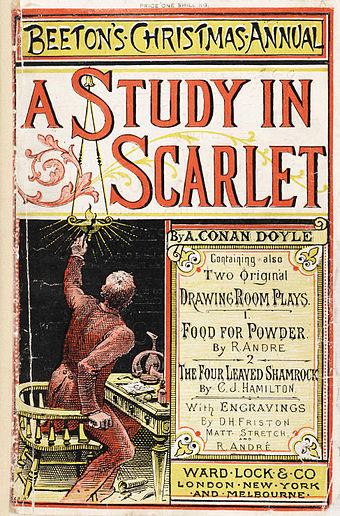
First appearing in print in 1887's A Study in Scarlet, Sherlock’s popularity became widespread with the first series of short stories in The Strand Magazine, beginning with "A Scandal in Bohemia" in 1891. This series eventually totalled to four novels and 56 short stories. All but one are set in the Victorian or Edwardian eras, between about 1880 and 1914. Most are narrated by the character of Holmes's friend and biographer Dr. John H. Watson, who usually accompanies Holmes during his investigations and often shares quarters with him at the address of 221B Baker Street, London, where many of the stories begin.
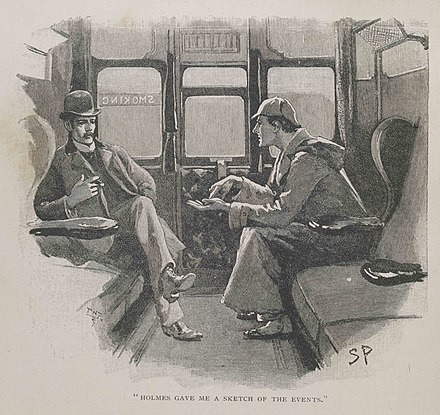
Although Sherlock isn’t the first fictional detective in stories, Holmes is arguably the best known. By the 1990s, there were already over 25,000 stage adaptations, films, television productions and publications featuring the detective, and the Guinness World Records even lists him as the most portrayed literary human character in all of film and television history.
Holmes's popularity hit an all time high to the fact that many belief him to be a real person and not just a fictional character in story books. Fans of the franchise helped create the modern practice of fandom. The character and stories have had a profound and lasting effect on mystery writing and popular culture as a whole, with the original tales as well as thousands written by authors other than Conan Doyle being adapted into stage and radio plays, television, films, video games, and other media for over one hundred years.
The inspiration behind Sherlock Holmes stemmed from Edgar Allan Poe's C. Auguste Dupin which is generally acknowledged as the first detective in fiction. Similarly, the stories of Émile Gaboriau's Monsieur Lecoq were extremely popular at the time Conan Doyle began writing Holmes, and Holmes's speech and behaviour sometimes follow that of Lecoq. Holmes and Watson discuss Dupin and Lecoq near the beginning of A Study in Scarlet.
Conan Doyle repeatedly said that Holmes was inspired by the real-life figure of Joseph Bell, a surgeon at the Royal Infirmary of Edinburgh, whom Conan Doyle met in 1877 and had worked for as a clerk. Like Holmes, Bell was noted for drawing broad conclusions from minute observations. However, he later wrote to Conan Doyle: "You are yourself Sherlock Holmes and well you know it". Sir Henry Littlejohn, Chair of Medical Jurisprudence at the University of Edinburgh Medical School, is also cited as an inspiration for Holmes. Littlejohn, who was also Police Surgeon and Medical Officer of Health in Edinburgh, provided Conan Doyle with a link between medical investigation and the detection of crime.
Watson describes Holmes as "bohemian" in his habits and lifestyle. Described to have a "cat-like" love of personal cleanliness, Holmes is an eccentric with no regard for standard tidiness.
Watson describes him as
“in his personal habits one of the must untidy men that ever drove a fellow-lodger to distraction. [He] keeps his cigars in the coal-scuttle, his tobacco in the toe end of a Persian slipper, and his unanswered correspondence transfixed by a jack-knife into the very centre of his wooden mantelpiece. ... He had a horror of destroying documents.... Thus month after month his papers accumulated, until every corner of the room was stacked with bundles of manuscript which were on no account to be burned, and which could not be put away save by their owner.”
While Holmes can be dispassionate and cold, when pulled into an investigation, he is animated and excitable. He has a flair for showmanship, often keeping his methods and evidence hidden until the last possible moment so as to impress observers.
Except for that of Watson, Holmes avoids casual company. In "The Gloria Scott", he tells the doctor that during two years at college he made only one friend: "I was never a very sociable fellow, Watson ... I never mixed much with the men of my year".
The detective goes without food at times of intense intellectual activity, believing that "the faculties become refined when you starve them."
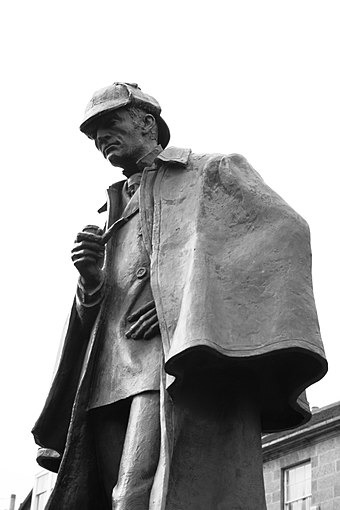
Although Holmes is not the original fictional detective, his name has become synonymous with the role. Doyle's Sherlock Holmes stories introduced multiple literary devices that have become major conventions in detective fiction, such as the companion character who is not as clever as the detective and has solutions explained to him (thus informing the reader as well), as with Dr. Watson in the Holmes stories. Other conventions introduced by Doyle include the arch-criminal who is too clever for the official police to defeat, like Holmes's adversary Professor Moriarty, and the use of forensic science to solve cases.
The Sherlock Holmes stories established crime fiction as a respectable genre popular with readers of all backgrounds, and Doyle's success inspired many contemporary detective stories. Holmes influenced the creation of other "eccentric gentleman detective" characters, like Agatha Christie's fictional detective Hercule Poirot, introduced in 1920.
The phrase "Elementary, my dear Watson" has become one of the most quoted and iconic aspects of the character. However, although Holmes often observes that his conclusions are "elementary", and occasionally calls Watson "my dear Watson", the phrase "Elementary, my dear Watson" is never uttered in any of the sixty stories by Conan Doyle. One of the nearest approximations of the phrase appears in "The Adventure of the Crooked Man" when Holmes explains a deduction: "'Excellent!' I cried. 'Elementary,' said he."
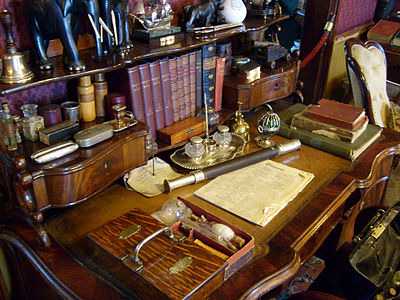
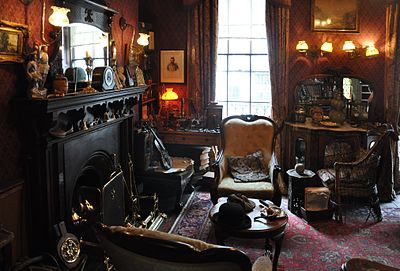
For the 1951 Festival of Britain, Holmes's living room was reconstructed as part of a Sherlock Holmes exhibition, with a collection of original material. After the festival, items were transferred to The Sherlock Holmes (a London pub) and the Conan Doyle collection housed in Lucens, Switzerland by the author's son, Adrian. Both exhibitions, each with a Baker Street sitting-room reconstruction, are open to the public.
In 1969, the Toronto Reference Library began a collection of materials related to Conan Doyle. Stored today in Room 221B, this vast collection is accessible to the public. Similarly, in 1974 the University of Minnesota founded a collection that is now "the world’s largest gathering of material related to Sherlock Holmes and his creator". Access is closed to the general public, but is occasionally open to tours.
In 1990, the Sherlock Holmes Museum opened on Baker Street in London. A private Conan Doyle collection is a permanent exhibit at the Portsmouth City Museum, where the author lived and worked as a physician.
Sources:
https://en.wikipedia.org/wiki/Sherlock_Holmes
0 notes
Text
Seven Percent Solutions
On October 20, 1930, Sherlock Holmes arrived on radio, and he would remain on the airwaves for nearly two decades. Holmes of course was already popular from the stories of Sir Arthur Conan Doyle and a stage play that toured the country starring William Gillette as the sleuth. But it wasn’t until actress, writer, and producer Edith Meiser persuaded NBC to take a chance on the character’s radio prospects that Holmes made his way into homes throughout the United States. For nearly ten years before Basil Rathbone first donned the deerstalker cap in The Hound of the Baskervilles, Sherlock Holmes was a mainstay on American radio.
In honor of the anniversary of that first broadcast, I’ve compiled a list of my favorite radio adventures of the master detective of Baker Street. These episodes, a mix of Conan Doyle adaptations and original radio mysteries, will make a fine playlist as you celebrate the on-air career of Sherlock Holmes and his loyal friend and biographer, Dr. John H. Watson.
“The Immortal Sherlock Holmes” – Technically not an episode of the Holmes radio series, but I think you’ll forgive my making an exception for Orson Welles. In this episode of The Mercury Theatre On the Air (a show that aired a month before the infamous “War of the Worlds” broadcast), Welles adapts and stars in a radio version of the Gillette play, a story that blends elements of several Holmes stories into one adventure pitting the sleuth against his nemesis Professor Moriarty. Ray Collins, years before he was Lt. Tragg on Perry Mason, narrates as Dr. Watson, and Eustace Wyatt plays Moriarty in this top-notch production from one of radio’s best dramatic anthologies. (Originally aired on CBS on September 25, 1938)
“The Notorious Canary Trainer” – To generations of fans, Basil Rathbone is Sherlock Holmes. Rathbone made an indelible impression as the detective in fourteen films between 1939 and 1946, but he also starred in hundreds of radio episodes alongside Nigel Bruce in The New Adventures of Sherlock Holmes. These shows, written by Anthony Boucher and Denis Green, are fantastic, and one of the best is this original mystery about a murderer who confesses before he commits suicide, but there is no evidence of a killing beyond two dead canaries found at the scene. (Originally aired on Mutual on April 23, 1945)
“The Second Generation” – One of the most famous stories in the Holmes canon is “A Scandal in Bohemia,” the tale that introduced Irene Adler. Known forever to Holmes as “the woman,” the beautiful and brilliant Adler has appeared in nearly all of the recent Holmes adaptations (the Robert Downey, Jr. films, Elementary, and Sherlock), and subsequent works have explored the exact nature of the relationship between Holmes and his lovely adversary. This Green and Boucher script acts as a sequel to “Bohemia” (a story they adapted on the series one week prior), and it tells of Holmes and Watson’s encounter with Irene’s daughter two decades later. One of the great things about the Green/Boucher run was they explored the entire timeline, with stories set in the early days of the Holmes/Watson partnership, some during the “great hiatus” after Holmes supposed death, and some in Holmes’ later years of semi-retirement as a beekeeper. “The Second Generation” is one of those “Holmes in twilight” stories, and it adds an additional level of emotion to the proceedings. (Originally aired on Mutual on December 17, 1945)
“The Adventure of the Tolling Bell” – After Basil Rathbone left the role of Holmes in 1946, Tom Conway took over as the detective for one radio season. He stars as Holmes in this mystery set in the idyllic English countryside. A vacationing Holmes and Watson (Nigel Bruce) learn of a strange series of deaths in the village when they come to the aid of a young woman. Their investigation leads them to a demented villain’s reign of terror and a showdown in a church bell tower. It’s a classic example of the “small town with a secret” genre, and it proves once again (as Holmes said in “The Copper Beeches”) the lowest and vilest alleys in London do not present a more dreadful record of sin than does the smiling and beautiful countryside." (Originally aired on ABC on April 7, 1947)
“The Case of the Sudden Senility” – Listeners of the podcast will know that my favorite radio Holmes is John Stanley, and my favorite run of episodes is Stanley’s 1947-48 season – a year where he was supported by Alfred Shirley as Watson and performed scripts penned by Edith Meiser. In this Meiser original that serves as an unofficial sequel to Doyle’s “Silver Blaze,” Holmes and Watson investigate when a five year-old horse dies in his stable of old age. The case involves a black cat, a mysterious house, and an appearance from Holmes’ greatest enemy. (Originally aired on Mutual on January 11, 1948)
“The Empty House” – Edith Meiser adapts the story that brought Holmes back from the dead. Watson has been soldiering on after Holmes’ apparent battle to the death with Moriarty, and he’s called in to consult on a baffling locked room murder case. It isn’t long before Holmes reveals his presence (in a wonderful scene that shows off John Stanley’s versatility, he plays an irascible bookworm who harangues Watson about his treatment of books) and explains the connection Watson’s case has to one of Moriarty’s most dangerous associates. (Originally aired on Mutual on April 11, 1948)
“The Final Problem” – This one may have the greatest cast of any Holmes radio adaptation. John Gielgud is the great detective, Ralph Richardson is Dr. Watson, and special guest star Orson Welles is the Napoleon of crime – Professor Moriarty. Edith Meiser never adapted the story where Conan Doyle killed off his hero, but it was used for the 1955 British series from producer Harry Alan Towers. The entire Gielgud/Richardson series is superb, presenting wonderfully faithful adaptations of the original stories, but if you only listen to one episode make sure it’s this one. The showdown between Holmes and Moriarty in the detective’s rooms in Baker Street is a glorious scene played to the hilt by Gielgud and Welles (who may be the only actor who played both Sherlock Holmes and his greatest enemy on radio).
Enjoy! And for more radio Holmes, check out Down These Mean Streets this Sunday for three original adventures starring John Stanley and Alfred Shirley.
Get more old time radio detectives here!
7 notes
·
View notes